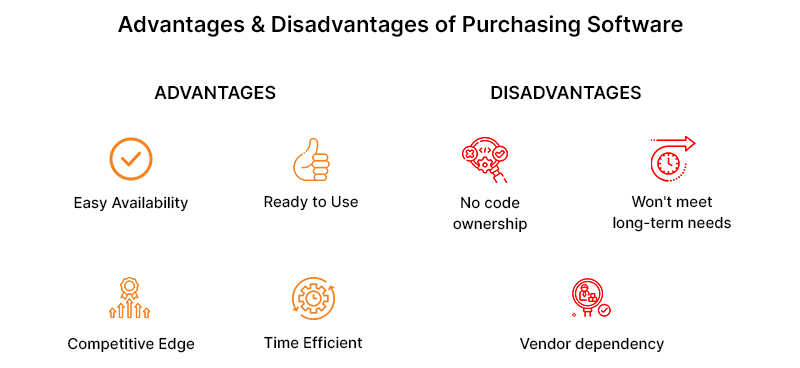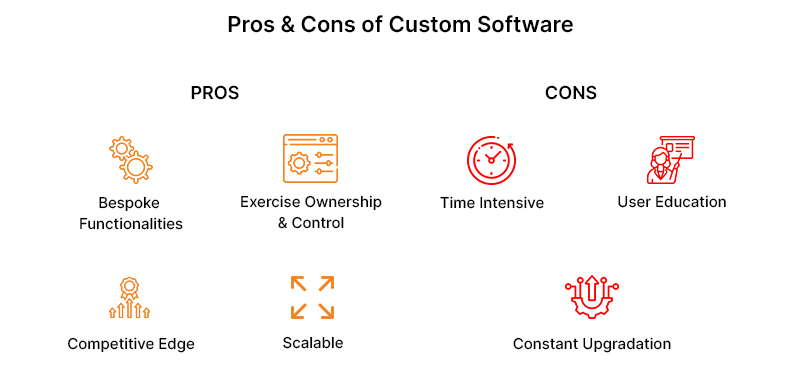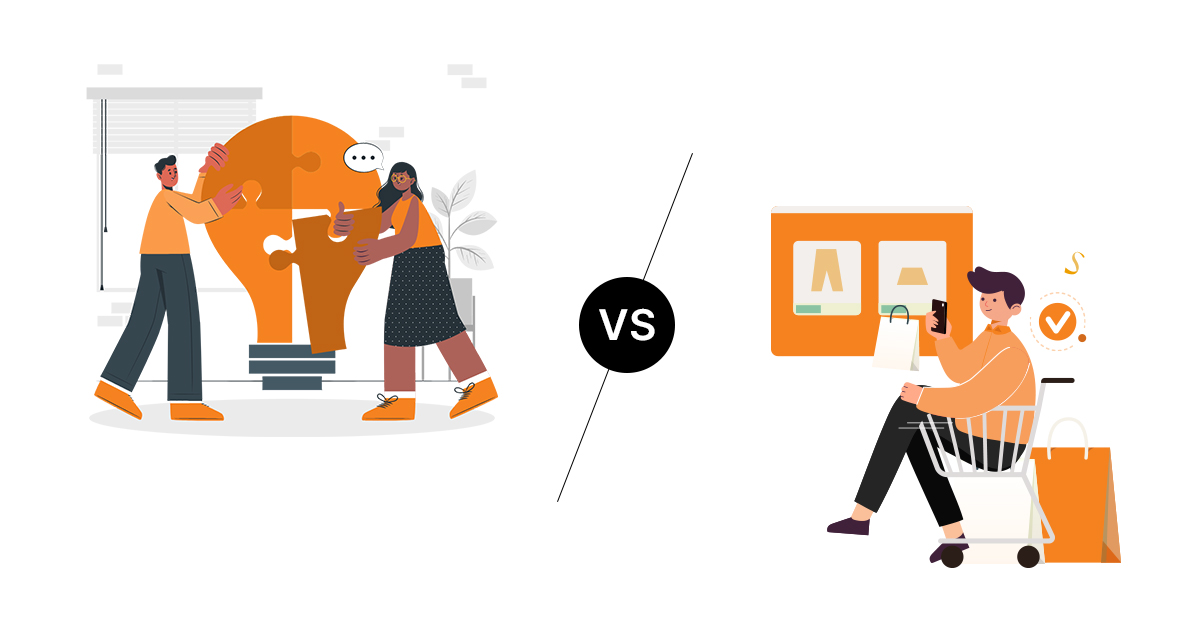“Is it better to develop the software from scratch or purchase it?”
This is the most prevalent and complicated problem managers face. The question of whether to develop or purchase a tool to simplify the activities of your employees better is one that managers frequently fight with. The reason is that it compares apples to oranges while balancing the present demands of your enterprise with long-term objectives.
This is why launching software is challenging because the majority of enterprises have the tools and expertise on staff to create it. As a result, “Can we do it?” is no longer as important as the question of “Should we do it?”
To help you with such confusion, we are here. Continue reading to learn how you can decide whether to purchase or develop software on your own and the advantages and disadvantages of each of these options.
Build vs. Buy: The pros and cons
Building and purchasing software have their own advantages and drawbacks. You just have to emphasize which advantages you prefer more and which disadvantages you would like to avoid.
The Advantages of creating your software:
- Development and functionality are entirely under your control.
- The software meets your conditions.
- The programming code remains your business.
- The advantage could be yours if your opponents don’t already have similar software.

The Drawbacks of creating your software:
- Determining the precise business requirements, writing the code, integrating with several other enterprise solutions, and then adapting to user queries after installation takes significant time.
- Users must be trained, and the IT or HR team must always support the application.
- It can be challenging to stay up to date whenever business requirements shift quickly, and the programs connected to the new versions require modifications to your system.
- Usually, the software will be less effective than one from a provider.
The Advantages of purchasing your software:
- Software that is readily available will be much less expensive.
- The software may be used for your enterprise almost instantly, giving you an edge over peers in terms of time-to-market.
- You don’t have to spend more money or time on it because the provider will take better care of it.
- External software developers are legally required to keep the products up to date with market dynamics and functionality additions.

Cons of purchasing software:
- Code ownership remains with the developer.
- Vendor-determined product functionality might only sometimes precisely meet your company’s demands.
- Depend on the vendor’s assistance to solve problems.
Now that you know the significant benefits of each strategy, let’s discuss how you may make a well-informed choice.
How do you choose between buying and building?
What is the line between Internal software development and a no-code software purchase?
Any one of these will lead you down a distinct track of more actions to take, choices to think about, and assessments to develop.
If you choose to develop software internally;
You must first evaluate the present level of manpower. The development staff, are prepared for that as well? Do the employees have the necessary knowledge and time to work on this big venture? Do you require the services of independent application developers? When could you anticipate receiving a system that works perfectly?
If you choose to purchase software;
You must first provide answers to inquiries regarding the research and review. Do you have a certain kind of enterprise software in mind? Which are essential aspects? Are the appropriate technologies easily accessible?
There are a plethora of issues to be addressed. Hence, let’s divide it into simple steps.
1. What’s the issue that you’re trying to fix?
Start by asking reasons why you require new software and why right now. Follow through on the objectives you intend to accomplish with the new software. As an example, objectives might be:
- Gaining an edge over its competitors by providing something unique
- Expanding into emerging markets, industries, or demographic groups
- Adaptation to constantly changing industry trends.
- A rise in client satisfaction rates
This will be simpler for you to choose if you have a proper grasp of the issue you’re trying to address, the intensity of the situation, and the objectives you’re trying to achieve.
2. What might you require to reach your objectives?
To resolve your “build vs. buy” conflict, evaluate the materials you already have and choose what needs to be built or implemented to meet your short- and long-term targets.
Here are a few vital components you’ll have to consider to reach your objectives appropriately.
Time:
Calculate the time required to construct a workable system and the time required to assess current software. Can a suitable period be met for the development of bespoke software? However, do you have to use the time the development team has allocated to you to resolve this issue?
Expenditure:
Several businesses need designated funding for the internal development of enterprise-level software. Defending a yearly software licensing price expenditure may be simpler than a fixed monthly payment. Nevertheless, the value of these investments keeps rising.
Tools:
Specifically, this relates to your existing systems, processes, libraries, partnership community, and general core skills. Would the new software easily connect with the current tools? Have any security concerns? Does the software provider you’re considering offer innovative, customized software?
Potential:
This will be a massive initiative for the enterprise if you choose to develop it yourself or purchase it. Analyze the initiative’s entire scope, taking into account the briefings, private communications, and strategy meetings. Include the objectives, plans, and particular tasks in the calculation.
Pro tip: Remember to incorporate consumer feedback into the strategy as well. And besides, you’re creating unique software that can benefit the clients. The most effective method for obtaining insightful feedback would be conducting in-product assessments and determining what current consumers think and require.
3. When will you anticipate seeing a return on investment?
- Identify all the components, problems, assets, procedures, etc., which could incur costs for the custom software development and the third-party software.
- Then, add everything up and make an informed prediction as to when you’ll start to get a profit (ROI). Is it within your price range? What if it costs more than expected?
- Consider all potential hidden expenses that arise before anything else. This may entail continuing expenses for upkeep, unforeseen problems, additional time for creation and review, continuing expenses for services, and much more.
- Conduct your analysis, compile the findings, and use them as a starting point for comprehending the situation and what you intend to accomplish over time. Get other people involved in the process.
- Utilize cooperative strategies to boost engagement and consider diverse viewpoints and views. For everybody’s convenience, ensure you develop a different plan for each alternative.
Wrapping Up
Hopefully, with the steps mentioned above, you will come to a conclusion.
In the podcast “Better ROI from Software Development” Mark Taylor iterates, “Traditionally when we’ve talked about buy, there’s been an expectation that you’re gaining economies of scale, that you’re buying from somebody that’s built it before. Thus, you’re paying a fraction of what you’d have to pay to build it yourself.
It doesn’t always work that way, unfortunately.
There is a real danger here that you’re paying over the odds because you’re actually buying much more than you would ever need. You’re buying a product that’s been built for many different use cases. And to be honest, you may not be using most of them. You may effectively be paying too much – for stuff that you will never, ever use.”
In our experience and research, buying is generally not as cheaper or convenient as building. And besides, why resolve an issue again if a business solution has already done so? Why not concentrate on a brand-new, more captivating issue?
However, you must choose a partner with a lot of experience and knowledge, like Netsmartz. Thanks to our knowledgeable staff and 20+ years of combined experience, we’re eager to develop your unique enterprise software.
So, without further ado, schedule a free consultation right away.
Summary
Kickstart Your Project With Us!
Popular Posts
CONTACT US
Let's Build Your Agile Team.
Experience Netsmartz for 40 hours - No Cost, No Obligation.
Connect With Us Today!
Please fill out the form or send us an email to







